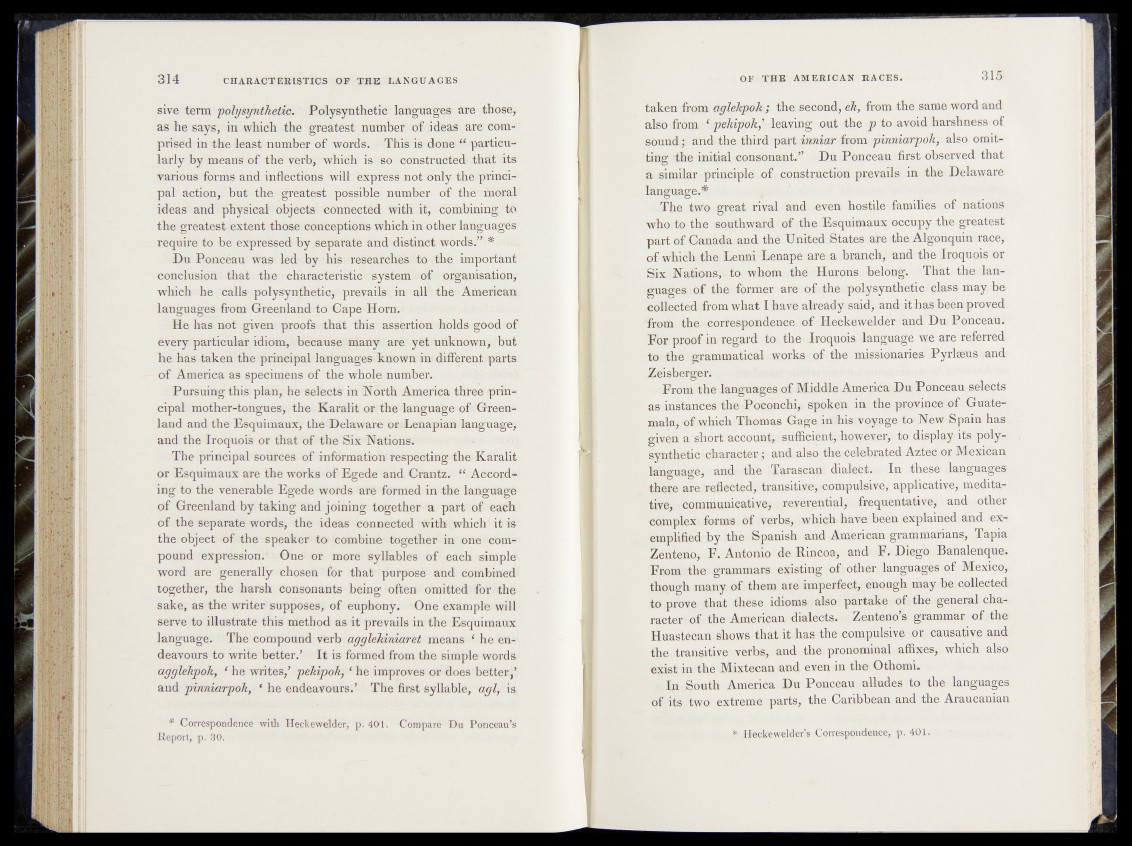
sive term polysynthetic. Polysynthetic languages are those,
as he says, in which the greatest number of ideas are comprised
in the least number of words. i This is done “ particularly
by means of the verb, which is so constructed that its
various forms and inflections will express not only the principal
action, but the greatest possible number of the. moral
ideas and physical objects connected with it, combining to
the greatest extent those conceptions which in other languages
require to be expressed by separate and distinct words.” * .
Du Ponceau was led by his researches to the important
conclusion that the characteristic system of organisation,
which he calls polysynthetie, prevails , in all the American
languages from Greenland to Gape Horn.
lie has not given proofs that this assertion holds good of
every particular idiom, because many are yet unknown, but
he has taken the principal languages known in different parts
of America as specimens of the whole number. ,
Pursuing this plan, he selects in North America three principal
mother-tongues, the Karalit or the language of Greenland
and the Esquimaux, the Delaware or Lenapian language^
and the Iroquois or that of the Six Nations.
The principal sources of information respecting the Karalit
or Esquimaux are the works of Egede and Granted “ Accord1*
ing to the venerable Egede words are formed in the language
of Greenland by taking and joining together a part of each
of the separate words, the ideas connected with which it is
the object of the speaker to combine together in one com*
pound expression.- One or more syllables of each simple
word are generally chosen for that purpose and combined
together, the harsh consonants being often omitted for the
sake, as the writer supposes, of euphony. One example will
serve to illustrate this method as it prevails in the Esquimaux
language. The compound verb agglekiruaret means ‘ he endeavours
to write better/ It is formed from the simple words
agglehpoh, * he writes/ pekipok, ‘ he improves or does better/
and pinniarpoh, ‘ he endeavours/ The first syllable, agl, is.
* Correspondence with Heckewelder, p. 401. Compare1 Du Ponceau’s
Report, p. 30.
taken from aglehpok; the second, eh, from the same word and
also from | pekipok,7 leaving out the p to avoid harshness of
sound; and »the third part imwtr from pinniarpoh, also omitting
the initial consonant.” Du Ponceau first observed that
a similar pddppte of construction :prevails in the Delaware
language.*
The two great rival and even hostile families of nations
who. to the southward of .the, Esquimaux occupy the greatest
part of Canada and the United States are the Algonquin race,
of which the Lenoi Lenape ere a branch, and the Iroquois or
Six Nations,, to whom the Hurons belong.
gauges i of the former arerof tho-polysynthetiei class may be
collected from what I have abeady said, and it has been pro ved
from the correspondence-: tef Heokewclder and Du P onceauJ
For proof in regard to the» Iroquois language we are referred,
to the grammatical works of the missionaries Pyrteusvand
Zeisherger.
From the languages of Middle America Du Ponceau selects
as instances the Poconchi, spoken in theprqvinceefGuate-
mala^of which Thomas Gage Whisivoyage to. New Spaia has .
given a short account, sufficient, however to display, its polysynthetic
character ; and ala® the seelebrated Aztep. or Mexican
language, and- the Tarascan dialect. In theserfanguages
there are reflected, transitive, compulsive, applieativepmedita^
tive, communicative, reverential, frequentative,’ and other:
complex forms of verbs, which have: been explained and ex*
emplified by the Spanish and American grammarians, Tapia
Zenteno, F. Antonio de Rincoa, and F. Diego Eanalenque.
From the grammars existing of-other langnages qf Mexico,.,
though many of them are imperfect, enough may be collected
to prove that these idiom9 also partake o£ the-general character
of the American dialects. Zenteno’s grammar . of the
Huastecan. shows that it has. the, compulsive .or causative and
the transitive verbs, and the: pronominal affixes* which also
exist in the Mixtecan and even in the Othomi. <•
In. South America Du Ponceau alludes to the languages
of its two extreme parts, the Caribbean and the Araucanian
* Heckewelder’s Correspmdence, p. 401.